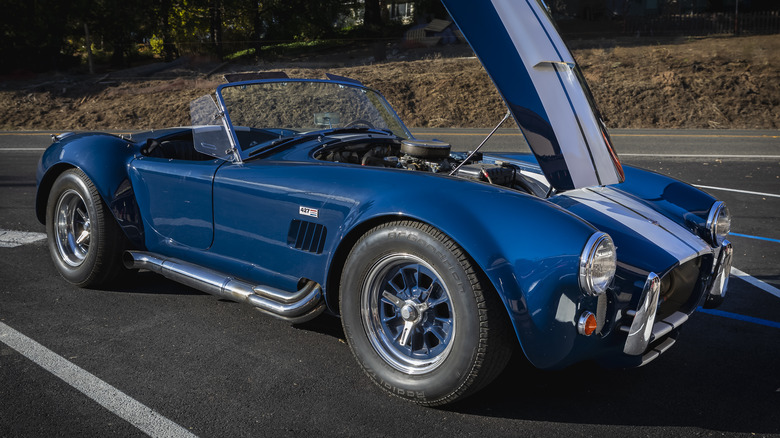
Svetlanasf/Getty Images
In 1958, Ford launched its new FE collection of V8 engines (quick for Ford-Edsel) to exchange the short-lived Y-block — itself a substitute for the actually antiquated flathead V8s. The FE was an amazing success by any measure, powering every part from farm gear to pickup vehicles to fire-breathing Shelby Mustangs till its discontinuation in 1976.
Perhaps probably the most well-known model of the FE engine is Ford’s 427 cubic inch (7.0 liter) big-block, which propelled its GT40 race automotive to beat Ferrari with first place finishes at 24 Hours of Le Mans in 1966 and 1967 — earlier than a guidelines change restricted engine displacement to a most of 5.0 liters.
Although closely based mostly on the identical 427 cubic inch engine that was accessible in a daily Ford Galaxie, the race engines had been placed on a food plan with an aluminum consumption manifold, aluminum cylinder heads, and a magnesium oil pan. All advised, the light-weight bits shaved roughly 130 kilos from the road 427.
In manufacturing vehicles, the pushrod 427 developed roughly 410-425 horsepower relying on the variety of carburetors, however in race tune, it was straightforward to squeeze an extra 100 horsepower from the 7.0 liter V8. In making ready for Le Mans, Ford briefly thought of operating a lately developed and unique overhead cam model of the 427 V8, but it surely was finally deemed too heavy and unwieldy for the compact GT40 street racers.
An overhead cam model was outlawed by NASCAR
SvetlanaSF/Shutterstock
If the overhead cam variation of the 427 was too cumbersome for the slinky GT40, then it was simply good for the massive engine bays of NASCAR inventory vehicles, in addition to uncovered drag racing purposes. Although overhead camshafts — camshafts contained throughout the engine’s cylinder heads — dominate trendy engine design, it was innovative know-how within the mid-Sixties, particularly from a home automaker.
The overhead cam (nicknamed the “Cammer”) 427’s participation in NASCAR racing was met with excessive resistance. In 1964, NASCAR head honcho Bill France turned down Ford’s request to compete with the brand new motor. Since Ford desperately wanted a technique to remain aggressive towards Chrysler’s new 426 cubic inch engine with hemispherical combustion chambers (the Hemi), it cast on with creating the Cammer anyway.
Later that 12 months, NASCAR banned all “special racing engines,” which included not solely Ford’s Cammer, but in addition the Chrysler Hemi. In retaliation, Chrysler really withdrew from NASCAR racing for a time period, however Ford was extra accepting of the edict and continued to race with its standard pushrod model of the 427. This was the identical engine sort that powered many examples of the GT40 and Shelby Cobras of the period.
Ford finally withdrew racing assist altogether
adolf martinez soler/Shutterstock
Spurned from inventory automotive racing, Ford targeted the overhead cam 427 on quarter-mile drag racing. Stuffed into prime gasoline dragsters and the newly rising humorous vehicles — which approximated the looks of standard manufacturing automobiles — the “Cammer” was fed nitromethane gasoline as a substitute of gasoline, and compelled induction was added within the type of an enormous supercharger.
With these modifications, the overhead cam 427 might produce as a lot as 2,500 horsepower, however its Achilles heel was the seven-feet-long timing chain that snaked throughout the entrance of the engine to drive the camshafts mounted excessive within the cylinder heads. With the assistance of aftermarket suppliers comparable to Crane Cams, drag racers developed a extra sturdy gear-drive system to exchange the timing chain.
In the later half of the Sixties, Ford began to withdraw funding and assist for the 427 Cammer in drag racing, marking the tip of an fascinating period. Some drivers, comparable to Connie Kalitta and “Sneaky Pete” Robinson, noticed potential within the engine. The two campaigned for these engines into the early Nineteen Seventies with out official backing, however finally, nearly all prime gasoline and humorous automotive drivers adopted Chrysler’s Hemi because the mill of alternative.
Whether it was the pushrod model for NASCAR and street racing, or the unique overhead cam drag racing powerplant, the competitiveness of Ford’s 427 cubic inch massive block within the mid to late Sixties can’t be overstated, fulfilling Ford’s long-time mantra of “Win On Sunday, Sell On Monday.”
…. to be continued
Read the Original Article
Copyright for syndicated content material belongs to the linked Source : SlashGear – https://www.slashgear.com/1326114/fords-427-big-block-racing-dominate/
